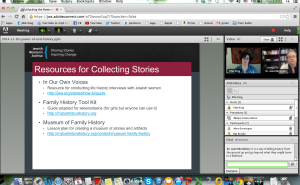This includes but is not limited too, virtual tours, Exhibit-based facilitations, Webinars, and online collections.
Methods of Virtual Interactive Programs
A Virtual Tour is one in which a participant can “tour” a museum through digital access without being present in the museum.
An Exhibit-based Facilitation is one that occurs entirely over digital media. Participants engage in exhibit interaction through over the internet and pre-planned, accessible activities are provided for the participant’s selective engagement.
A Webinar is a tool used, in this case, by educators, curators, or individuals otherwise responsible for spreading information, to help audiences utilize the museums. This is not necessarily distance learning for the purpose of learning about something in a museum, but rather learning about how to teach or learn what is in a museum.
An Online Collection is a museum’s way of making its collection accessible to audiences who cannot travel to the museum. Once again, online collections are accessed digitally.
In my opinion, I have rated these from least interactive to most interactive in the following order: Online collections, Virtual Tours, Exhibit-Based Facilitations, and Webinars. The latter two are similarly interactive, but their appropriateness dependent on the audience. My case study will be reviewing the Webinar.
A closer look at a Method: Webinar
Webinars are designed with specific audiences in mind. To clarify from the definition above, Webinars are virtual conferences or meetings that employ the use of audio, video, real-time polls, group text conversations, collaborative “blackboard”, slideshow availability, note-taking, and availability to record for later use. It is an educational tool that I researched in the context of museums, but not in museums. In preparation for this post, I signed up for a Webinar provided by the Jewish Women’s Archive.
Who is the Audience?
The audience for this Webinar was Jewish Educators of all denominations, of all ages and experience levels, and from all over the United States. We had 14 individuals present, including the facilitator, from Boston, MA; San Diego, CA; New York City, NY; Silver Spring, MD; Seattle, WA; and Los Angeles, CA.
Case Study and Review
“Teaching Oral History”, Webinar given by Etta King, Educational Programs Director of the Jewish Women’s Archive. This was a 1-hour long session, with two time slot options. The mission of the Jewish Women’s Archive is to “The Jewish Women’s Archive documents Jewish women’s stories, elevates their voices, and inspires them to be agents of change.” Additionally, the goal of the Education Department of the JWA is to “enhance [educators’] work through high-quality curricular resources and professional development.”
The topic of the session, “Teaching Oral History”, was one that is relevant to collecting information in a way that is relevant and interesting to young learner’s (and learners of all ages!), and was a forum during which the facilitator switched between informative presentation and interactive creation and compilation of group ideas. This Webinar hit on both of the organization’s overarching goals while engaging with its participants and providing tools for them to use in their own educational environments. Additionally, this forum was a living conversation about how to sustain the type of information we have in museums. Below is screen shot from the Webinar, including some of the sources given.
I think the use of Webinars is an engaging virtual interactive. Its limitations are that it applies to specific audiences, you need to sign up to gain access, and I could only find examples of Webinar use that were once removed from museums. (I.E..- The JWA used this Webinar to reach out to educators, below there is an example of a Webinar from AAM, but it is not meant to reach out to museum visitors, but rather to individuals looking to expand digital access to museums, etc.)
On the other hand, there are so many strengths to this type of program! It has multimedia interaction (audio, video, group chat, group “blackboard” where everyone can draw on a graph at the same time, instantaneous polling, slideshow viewing.. the list goes on!) It is highly interactive and (even though I included this in my limitations of the program) it can be specified to your audience! For example: our thoughts and creation of ideas were added to the slideshow, the entire experience was recorded and sent out to the participants, there was a tech assistant on hand to handle any glitches as they arose, and each portion of the facilitation was built upon our experiences and input.
While I do believe there is nothing like visiting a museum and experiencing it with as many of your senses as possible, there is something to be said for Virtual Interactive Programs. In the pursuit expanding accessibility, it is notable that all of these programs have the ability to bring museums to the learner regardless of their ability (or inability) to get to a museum.
Links to Examples*
Virtual Tours
National Postal Museum: http://postalmuseum.si.edu/visit/virtual-tour.html
Museum of Natural History: http://www.mnh.si.edu/vtp/2-mobile/
Webinars
Jewish Women’s Archive:
-Website: JWA.org
-Upcoming Webinar(s): http://jwa.org/teach/profdev/webinars
American Alliance of Museums
-Website: www.aam-us.org
-Upcoming Webinar(s): https://aam-us.org/ProductCatalog/Product?ID=4008
*Note: AAM is using this Webinar as a teaching tool for educating about Digital Learning in Museums. Meta!
Exhibit-based Facilitation
National Museum of Natural History, Dinosaur Tour: http://paleobiology.si.edu/dinosaurs/interactives/tour/main.html
British Science Museum: http://www.sciencemuseum.org.uk/online_science.aspx
Online Collections
Metropolitan Museum of Art: http://www.metmuseum.org/collection/the-collection-online
Brooklyn Museum: http://www.brooklynmuseum.org/opencollection/collections/
The Guggenheim: http://www.guggenheim.org/new-york/collections/collection-online
The British Museum: http://www.britishmuseum.org/research/collection_online/search.aspx
*None of these lists is anywhere near a complete list! Just a fun group to peruse if you wish 🙂
